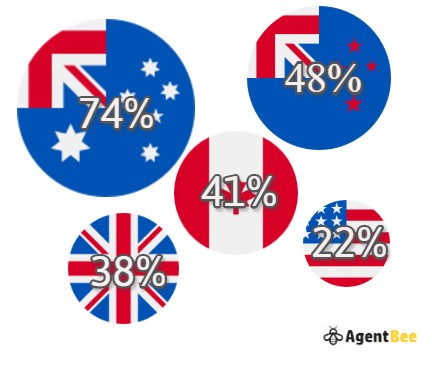Education agents are key players in international education. In the main destination markets they recruit a significant percentage of international students.
Estimated percentage of international students recruited by education agents by market.

Many educational institutions around the world work with education agents to enrol international students.
Working with education agents involves unavoidable risk. Your agents are representing your institution and brand. If they behave unprofessionally or dishonestly the results are usually ugly. Your institution’s brand and reputation will be tarnished and students will be hurt.
Educational institutions with a sound education agent strategy in place manage and reduce risk by:
- Doing due diligence on potential agents before agreeing to work with them, and
- Undertaking ongoing due diligence on their authorised education agents.
What about your sub-agent network?
If you are working with education agents you also have a much larger sub-agent network, whether you know it or not.
What is a sub-agent? It’s an education agent, or another type of business or individual, who refers students to one of your authorised agents for enrolment at your institution.
If one of your authorised agents receives a student referral from one of their sub-agents, and the student is ultimately placed at your institution, your authorised agent will typically split the commission with the sub-agent.
Many education agents work with sub-agents. Doing so extends their geographic reach and enables them to generate a higher volume of international student leads than would be possible through other marketing channels. Some specialist ‘master agents’ focus entirely on growing and managing very large networks of sub-agents or referral partners.
The issue for you as an educational institution is that the sub-agent model creates a second tier of agents beneath your authorised agents over which you have no, or at best much reduced, visibility.
- Who are those sub-agents and where are they based?
- What are those sub-agents doing?
- Are they purporting to represent your institution?
- Are they using your institution’s brand in marketing or promotional material?
- What happens if a sub-agent behaves unprofessionally or dishonestly?
Feeling uneasy?
Imaginary risk management
At this point you might say:
Sub-agents are not a problem for my institution because we don’t allow our authorised education agents to work with sub-agents.
You’re not alone in taking that position. We see lots of education agent agreements and contracts and many of them explicitly forbid the agent from working with sub-agents.
Here’s the thing. It still happens.
An independent report commissioned by the Association of Australian Education Representatives in India (AAERI) found that “agents are collaborating and in some cases signing agreements with sub/referral agents without permission from their institutional partners.”
One challenge here is that the definition of a sub-agent is very grey. For example, is a migration agent who refers a student to one of your authorised agents for enrolment a sub-agent or simply a ‘referral partner’?
The key takeaway here is that if your risk control measure on paper is that you prohibit your authorised agents from using sub-agents, but the evidence shows that it’s happening, then what you’re left with is no risk control at all.
Transparency is power
So how can you control the risks associated with the use of sub-agents by your authorised agents?
We’ve established that forbidding it doesn’t work.
The answer: communication and transparency.
It’s important that you talk to potential and current education agents to understand if they work with sub-agents or referral partners. If they do, you need a clear picture of that sub-agent network – who their sub-agents are, and the controls that your authorised agent has in place for the recruitment and management of sub-agents. For example are they conducting rigorous and ongoing background checks on their sub-agents?
Without that information you have zero visibility. You’re flying blind through risk that could have a serious impact on your institution’s brand and reputation, and potential international students.

Photo by davide ragusa on Unsplash
